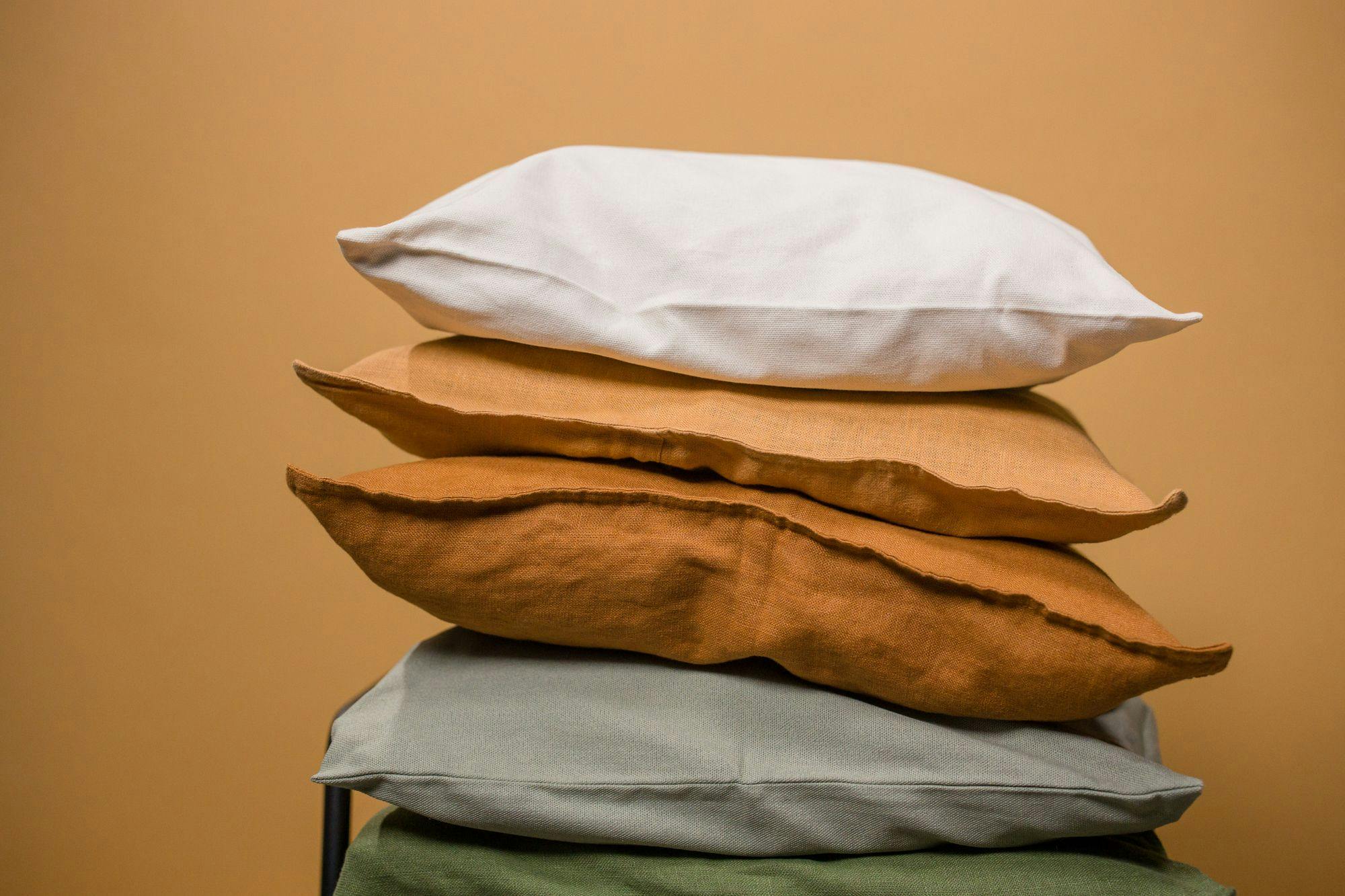Buckwheat pillows are packed with natural buckwheat hulls that conform to the shape of the head and neck.
One question that many people wonder about buckwheat pillow is how long do they last, and how often to replace buckwheat pillow?
With proper care and maintenance, a high-quality buckwheat pillow may last anywhere from 10 to 20 years.
This longevity is one of the most appealing qualities of buckwheat pillows, and its lifespan surpasses that of typical pillows.
Key Takeaways
- Buckwheat pillows can provide support and comfort for up to two decades.
- The longevity of these pillows is influenced by care, usage, and the quality of the casing.
- When buckwheat pillows lose their loft or support, it's time to consider a replacement.
Average Lifespan of Buckwheat Pillows
Unlike traditional pillows, buckwheat pillows can have a significantly longer lifespan.
I've found through personal experience and research that buckwheat pillows can last from 10 to 20 years with proper care. This sustainability comes from the robust nature of the buckwheat hulls, which are the filling material for buckwheat pillows.

The hulls maintain their shape and firmness over an extensive period of use. They resist breaking down, thereby providing consistent support.
Eventually, after many years, the hulls may begin to deteriorate. But even then, they are easy and cost-effective to replace, which I consider a huge advantage.
To prolong the life of a buckwheat pillow, routine maintenance is key. Below are some tips I adhere to:
- Regular Air-Out: I ensure to air out the pillow frequently to remove moisture and odors.
- Keep Dry: Protecting the pillow from moisture is crucial as dampness can degrade the hulls faster.
- Use a Protective Cover: A cover prevents dirt and spills from contaminating the hulls.
These practices, along with general care instructions provided by manufacturers, help to ensure that buckwheat pillows remain functional for many years.

I also noted in my research that some manufacturers suggest buckwheat pillows could last around 3 to 5 years, but this seems to refer to the lifespan without any hull replacement.
I am confident that a buckwheat pillow will be a long-term investment, offering durable and supportive rest for many years to come.
Factors Influencing Longevity
In my experience, several specific factors influence how long buckwheat pillows can maintain their structure and comfort.
Assessing these factors will give you a clear understanding of a buckwheat pillow's lifespan.
Quality of Buckwheat Hulls
Buckwheat pillows are filled with hulls from buckwheat, and the quality of these hulls directly impacts the pillow's longevity.
High-quality hulls can retain their structure and supportiveness for up to 10 to 20 years, whereas lower-quality hulls may deteriorate more quickly.
Pillowcase Material
The durability of the pillow's casing is also critical. A robust, high-quality pillowcase material can protect the buckwheat hulls, extending the overall life of the pillow.
Typically, you can expect a quality case to last about 2 to 3 years before replacement is needed due to normal wear and tear.
Usage Frequency
How often I use my buckwheat pillow will also affect its lifespan.
Consistent nightly use can compress the hulls faster than occasional use. However, buckwheat pillows are known for their ability to withstand daily use quite well.
Maintenance Practices
Proper maintenance is key to prolonging the life of a buckwheat pillow. This includes regularly cleaning the pillowcase, airing out the hulls, and avoiding exposure to damp conditions.
Refreshing or refilling the hulls can also rejuvenate an aging pillow, making it feel new again.
Signs of Wear and Replacement Indicators
Identifying when to replace buckwheat pillows is essential for maintaining sleep quality and hygiene. I'll discuss distinct signs that indicate it's time for a replacement.
Flattening of Hulls
Buckwheat hulls gradually flatten over time due to the weight of the head and the natural movement during sleep.
Once you notice your pillow is not as lofty and the hulls feel crushed, it's a clear sign that the pillow needs replenishing or replacing.
Stains and Odors
Pillows can accumulate stains and odors from sweat and oils.
If you detect persistent stains or odors that don't resolve with cleaning, consider this a prompt for pillow replacement.
Decreased Comfort and Support
When a buckwheat pillow no longer aligns with your neck correctly or fails to offer the necessary support resulting in discomfort, it indicates that the pillow is no longer serving its purpose optimally.
This loss of comfort and support suggests the pillow requires replacement.
How often to replace buckwheat pillow
Regular inspection for wear and addressing the pillow's condition is crucial. Typically, I advise inspecting your pillow every few years, but this varies based on usage.
However, if the previous indicators present themselves, it's advisable to replace the pillow regardless of the timeframe to ensure a restful sleep.
Remember, attentive maintenance can significantly extend your buckwheat pillow's lifespan, but responsiveness to these signs of wear is key to preserving your sleep health.
Care and Maintenance Tips
To ensure that my buckwheat pillow lasts as long as possible, proper care and routine maintenance are needed.
Cleaning Methods
Spot Cleaning: I spot clean my buckwheat pillow with a damp cloth and mild detergent, carefully avoiding getting the hulls wet.
Orders removing: For odors, I sometimes use baking soda, sprinkling it on the pillow, and then vacuuming it off after a few minutes.
Washing Covers: I remove the buckwheat hulls and wash the pillowcase and liner, if possible, according to the manufacturer's instructions. It's usually safe to machine wash them on a gentle cycle with cool water.
Hull Replacement
Assessment: Every few months, I check the buckwheat hulls for signs of breakdown. If they seem less supportive or are getting pulverized, I know it's time to add or completely replace them.
Purchasing Hulls: High-quality buckwheat hulls are essential for longevity, so I buy them from reputable sources to maintain the pillow's supportive qualities.
Storage Recommendations
Dry Environment: I store my buckwheat pillow in a dry, well-ventilated area to prevent moisture buildup which can lead to mold or mildew.
Avoid Compression: When not in use, I don't compress or fold the pillow, as this can damage the hulls. Instead, I keep it flat or hang it to ensure air circulation.
Comparison With Other Pillow Types
When comparing buckwheat pillows to other types, it's important to focus on longevity and durability.
This section illustrates how buckwheat pillows generally stand the test of time against other options.
Memory Foam Pillows
Compared to buckwheat pillows, memory foam pillows have a shorter lifespan due to their susceptibility to permanent indentations and decreased support over time.
Typically, memory foam pillows require replacement every 2-3 years, whereas buckwheat pillows can last significantly longer, often up to 10-20 years with proper care.
Down Pillows
Down pillows are known for their luxurious softness, but they too compress over time and can lose their shape.
They generally last between 5 to 10 years, but I have noticed that they require more frequent fluffing and may not provide consistent support throughout their life.
Buckwheat pillows maintain their shape much better, offering reliable support for a longer period.
Synthetic Fiber Pillows
Synthetic fiber pillows are also in the mix, being a cost-effective option for many. These pillows are usually the least durable, lasting only a few years before starting to clump or become flat.
Buckwheat pillows, with their ability to retain structure and support, offer a more durable alternative with a significantly longer lifespan.
Frequently Asked Questions
In this section, I cover some of the common questions about durability and maintenance for buckwheat pillows.
Do buckwheat pillows get moldy?
Buckwheat pillows have a reputation for durability, but like any natural product, they can develop mold if they're not kept dry.
It's crucial to ensure they are aired out regularly and protected from moisture.
If you live in a humid environment, it's advisable to use a breathable pillow protector to mitigate the risk.
How long do buckwheat pillows last?
Remarkably, the lifespan of a buckwheat pillow can reach 10 to 20 years.
The longevity is due to the robustness of the buckwheat hulls, which do not break down easily. Proper care, such as regular airing and keeping the pillow dry, significantly contributes to its extended lifespan.
When to replace buckwheat pillow?
You should consider replacing your buckwheat pillow if you notice it no longer provides sufficient support, has become noticeably flat or if the hulls have lost their natural springiness.
Another indicator might be a decline in the pillow's cooling properties, suggesting that the hulls have deteriorated.
YZ Li
YZ, an engineer with a PhD based in the San Francisco Bay Area, brings practical expertise to Restful Guides. Focused on simple, effective ways to improve sleep and relaxation, YZ offers easy-to-follow advice on choosing the right pillows, bedding, and meditation techniques for a better, more restful life.

